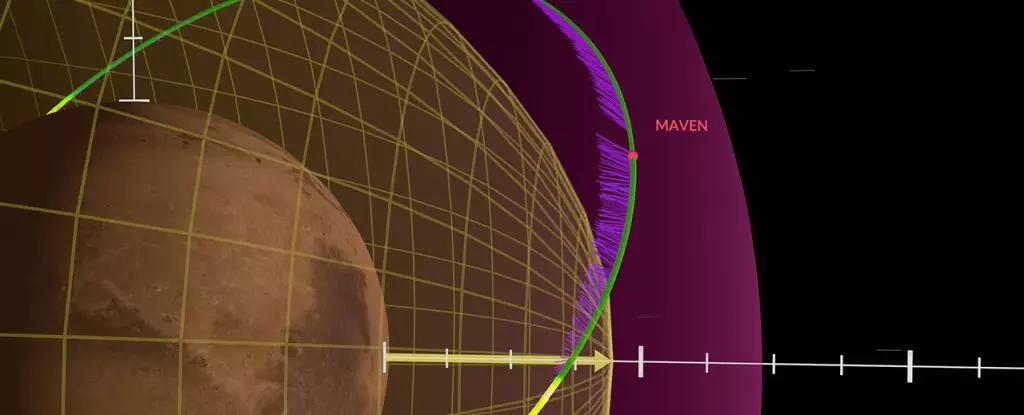In a surprising turn of events, the atmosphere of Mars experienced a remarkable expansion as a powerful gust of solar wind swept through the planet’s vicinity. On 26 December 2022, the MAVEN spacecraft, on its mission to orbit Mars, observed a sudden decrease in solar particles coinciding with a peculiar transformation in the Martian atmosphere. As a result, both the planet’s magnetosphere and ionosphere expanded significantly, increasing in size by more than three times. This extraordinary occurrence, last witnessed in 1999 when Earth’s magnetosphere swelled due to a drop in the solar wind, offers valuable insights into the behavior of Mars in response to sudden changes in its environment. Furthermore, it sheds light on the interactions between Solar System-like planets and their surrounding conditions, particularly when it comes to different types of stars. The importance of firsthand observations conducted by spacecraft orbiting various celestial bodies is further underscored by this unique measurement. Astronomer Jasper Halekas of the University of Iowa, the lead author of a new study on this event, expresses his astonishment, stating, “When we first saw the data and how dramatic the drop in the solar wind was, it was almost unbelievable. We formed a working group to study the event, and we have found this time period to be rich with incredible findings.”
The solar wind, consisting of a continuous stream of particles emanating from the Sun, permeates the entire Solar System, including all the planets within it. The strength of this stream, which generates ambient pressure throughout the system, can vary depending on solar activity. For instance, areas of weakened solar magnetic fields on the Sun’s surface can result in a more forceful solar wind, bombarding the Solar System with an increased number of particles. The gust of wind that passed by Mars in December 2022 exhibited a distinct quality. It comprised two solar winds: a slower one that was engulfed by a faster wind coming from behind, consequently merging into one powerful super wind. The MAVEN spacecraft detected higher particle densities resulting from this combined solar wind. However, upon the wind’s passing, the spacecraft recorded a significant drop in particle density, creating an unusual void of exceedingly weak and low-density solar wind. Additionally, the solar wind pressure experienced a considerable decrease, with density declining by a factor of 100 and pressure by a factor of 10.
As the pressure around Mars diminished, its atmosphere responded in unexpected ways. Typically, the solar wind exerts pressure on a planet’s magnetosphere, which, in the case of Earth, is primarily generated by the movement of its molten core. Although Mars lacks a global magnetosphere, it possesses an induced magnetic field resulting from the entanglement of magnetic fields within the solar wind and the planet’s ionosphere. Consequently, the ionosphere and induced magnetic field expanded considerably outward, as if Mars were releasing itself from a constricting corset. The induced magnetic field lost its magnetization, and the region between it and the solar wind, known as the bow shock, experienced a significant reduction in turbulence. This noteworthy development offers crucial insights into the process of atmospheric loss on Mars and similar planets scattered throughout the galaxy. Understanding these mechanisms plays a pivotal role in determining the habitability of a planet. Halekas emphasizes the significance of this finding, stating, “We are really getting to see how Mars responds when the solar wind is effectively removed. It makes for a great outlier study on what Mars would be like if it were orbiting a less ‘windy’ star.”
The team of researchers responsible for this study is currently presenting their unprecedented findings at the American Geophysical Union Fall Meeting in 2023. Their observations have unveiled a crucial aspect of Mars’ behavior and highlighted the importance of in situ measurements conducted by spacecraft. By exploring the effects of solar wind variations on Mars, scientists can gain valuable insights into the behavior and atmospheric evolution of other planets within and beyond our Solar System. As our understanding of these intricate dynamics continues to grow, it brings us one step closer to unraveling the mysteries of distant planets and potential habitats for life.



Leave a Reply